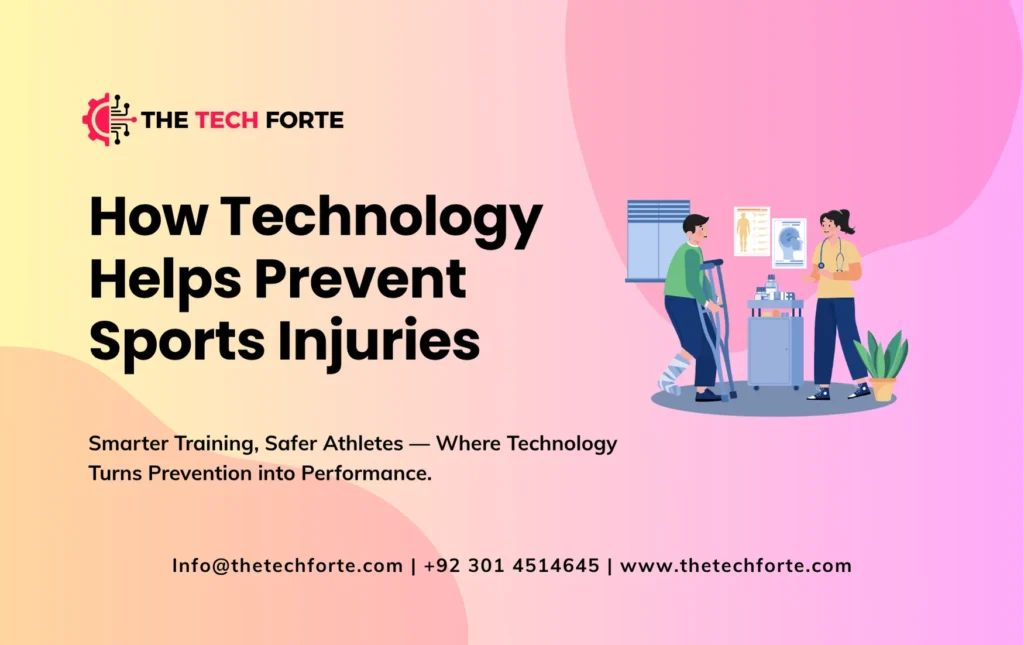How Technology Helps Prevent Sports Injuries

In the modern world of athletics, technology has evolved from a training aid into a powerful shield against sports injuries. From wearable tech for athletes to AI-powered injury prediction, innovation has revolutionized how athletes train, recover, and perform. Sports are now safer and smarter, thanks to the integration of sports science technology, biomechanics, and real-time performance monitoring.
Whether it’s preventing muscle strain, detecting early signs of fatigue, or tracking recovery progress, technology in sports injury prevention is reshaping the future of athletic performance. Let’s explore how advanced tools and systems are helping athletes stay healthy, extend their careers, and perform at their best.
The Role of Technology in Sports Injury Prevention
Technology plays a critical role in injury prevention in sports by combining data, science, and innovation. From motion sensors and AI algorithms to virtual reality training, each tool helps reduce the risk of injury before it happens.
Sports injury prevention technology allows trainers and athletes to monitor fatigue, stress levels, posture, and biomechanics in real time. These insights help adjust training intensity, avoid overexertion, and identify risks early.
In short, technology doesn’t just enhance performance — it prevents sports injuries before they occur, ensuring athletes can push their limits safely.
Wearable Tech for Athletes: The First Line of Defense
One of the most revolutionary developments in sports is wearable tech for athletes. Devices like smartwatches, GPS trackers, and motion sensors collect detailed data on an athlete’s movement, heart rate, and exertion levels.
These athlete health tracking devices provide coaches with precise information to tailor training loads and prevent overtraining. When the body shows early signs of fatigue or imbalance, wearables can issue alerts to reduce injury risk.
Brands are now integrating AI in sports injury prevention within wearables, making them capable of predicting potential sports injuries before they happen.
Sports Science Technology: The Power of Data and Insight
Sports science technology is the backbone of modern injury prevention strategies. It uses biomechanics, physiology, and data analytics to study how the body moves and reacts during physical stress.
Through advanced imaging, 3D motion capture, and performance metrics, experts can identify weak points in an athlete’s movement pattern. This knowledge helps design training routines that strengthen vulnerable areas and reduce the likelihood of injury.
By combining sports medicine technology with scientific analysis, teams can transform raw data into actionable injury prevention plans.
Biomechanics and Injury Prevention: Understanding Movement
Biomechanics and injury prevention go hand in hand. Biomechanics studies how forces interact with the body during motion — from running to jumping to throwing.
Using motion capture systems and force plates, specialists can analyze an athlete’s movements frame by frame. Subtle errors in technique or alignment that are invisible to the naked eye become clear through these tools.
Correcting these imbalances early helps in preventing muscle strain with technology, ensuring that athletes move efficiently and safely.
AI in Sports Injury Prevention: Predicting Problems Before They Happen
Artificial intelligence is taking sports injury prevention technology to a new level. By analyzing vast amounts of athlete data, AI-powered injury prediction systems can forecast potential injuries with remarkable accuracy.
AI uses machine learning to study past sports injuries, training loads, and body metrics to spot patterns that precede injury. When risk levels rise, the system warns coaches and athletes in real time.
This predictive power allows teams to adjust schedules, improve warm-ups, and apply preventive treatments before an injury strikes.
Read More: How AI Is Transforming the World of Sports Analytics
Real-Time Performance Monitoring: The Key to Early Detection
In elite sports, seconds matter — and so does every heartbeat. Real-time performance monitoring enables continuous tracking of vital signs, muscle activity, and hydration levels during training or competition.
This live feedback ensures athletes stay within safe physical limits. For example, wearable sensors for athletes can detect abnormal strain or fatigue instantly, alerting medical staff to step in.
This technology not only improves safety but also helps maintain consistent performance while minimizing injury risks.
Smart Wearables for Sports Injuries Safety
Smart wearables for sports safety are evolving fast. From pressure-sensing insoles that track running impact to compression garments that measure muscle fatigue, these devices act as the body’s personal guardians.
They record and analyze metrics like acceleration, balance, and force. The data helps prevent sports injuries by identifying improper form or excessive stress.
For instance, soccer players can wear shin guards with embedded sensors to detect potential impact risks, while runners can use smart shoes that alert them to overpronation or imbalance.
Sports Injury Detection Systems: From Monitoring to Action
Sports injury detection systems combine data analytics in sports health with AI and wearable sensors to identify early signs of injury.
These systems can detect inflammation, strain, or overuse in muscles and joints by monitoring temperature changes, motion irregularities, or heart rate variations.
When abnormalities appear, the system alerts trainers to intervene immediately, preventing a minor issue from becoming a major injury. This makes sports safety gadgets indispensable in modern athletics.
Sports Medicine Technology: Healing Through Innovation
Sports medicine technology focuses not only on treatment but also on prevention and faster recovery. Advanced tools like cryotherapy, laser therapy, and electrical muscle stimulation help reduce inflammation and accelerate healing.
Digital rehabilitation programs and sports rehabilitation technology allow athletes to follow personalized recovery routines through apps and sensors that track progress.
These technologies shorten downtime, reduce the risk of re-injury, and make rehabilitation more precise and efficient.
Data Analytics in Sports Health: Turning Numbers into Prevention
The real power of modern sports lies in data analytics in sports health. Every jump, sprint, and movement generates data — and when analyzed correctly, it reveals crucial insights into an athlete’s body and performance.
Analytics platforms track everything from training volume to fatigue patterns, helping coaches identify early warning signs of overtraining.
By applying predictive models, sports science technology can suggest optimal rest periods and training intensity, creating a perfect balance between performance and protection.
Motion Analysis in Sports: The Art of Precision Training
Motion analysis in sports uses high-speed cameras, sensors, and software to study how athletes move in extreme detail. This analysis identifies inefficient or risky movement patterns.
For example, pitchers in baseball use motion capture to refine their throwing mechanics, while runners analyze gait to avoid stress fractures.
Through such precision, biomechanics and injury prevention become proactive rather than reactive — a cornerstone of safe athletic training.
Tech Innovations in Sports Training
The field of tech innovations in sports training is rapidly expanding. Virtual reality simulators, AI coaching platforms, and biomechanical exosuits are now part of elite sports programs.
These innovations enhance skill development while reducing repetitive stress injuries. For instance, VR training helps athletes practice strategy and reaction without physical strain.
When combined with smart fitness devices, these tools make training safer, smarter, and more efficient.
Preventing Muscle Strain with Technology
Muscle strain is one of the most common athletic sports injuries — and also one of the most preventable. Preventing muscle strain with technology involves using wearables that monitor muscular tension and detect fatigue early.
Smart clothing with embedded EMG (electromyography) sensors tracks muscle activation, helping coaches adjust warm-ups and cooldowns accordingly.
Such insights reduce the risk of overexertion, ensuring athletes build strength without breaking down.
AI-Powered Injury Prediction: The Future of Sports Safety
AI-powered injury prediction systems are at the forefront of the sports industry. These tools analyze historical data, biomechanics, and even genetics to predict who is most at risk of injury.
Teams can then customize training plans to strengthen weak areas or limit exposure to specific stressors.
In the near future, this predictive technology will integrate with sports injury detection systems, offering real-time, personalized injury prevention strategies for every athlete.
Digital Tools for Sports Recovery
Recovery is just as vital as training. Digital tools for sports recovery — such as compression boots, massage guns, and recovery apps — help restore muscle function and reduce inflammation after intense activity.
Many of these devices sync with performance tracking apps for athletes, giving precise recovery recommendations based on workout data.
By improving recovery efficiency, athletes can train more consistently without increasing injury risk.
Technology and Athletic Performance: Striking the Right Balance
While technology enhances safety, its ultimate goal is to elevate athletic performance. The key lies in using digital tools wisely to balance training load, rest, and recovery.
Technology and athletic performance now work in harmony, allowing athletes to reach peak potential without compromising health.
By merging sports injuries prevention technology with smart coaching decisions, teams can achieve the perfect synergy between performance and protection.
The Future of Injury Prevention in Sports
Looking ahead, the future of injury prevention in sports will rely on even more advanced integrations of AI, biomechanics, and wearable sensors.
Athletes may soon wear lightweight smart suits that continuously monitor body stress, hydration, and micro-tears in muscles. Cloud-based analytics will provide coaches with real-time insights for instant intervention.
As sports technology becomes more intuitive, sports injuries could become a rarity rather than the norm.
Conclusion: Smarter Tech, Safer Athletes
Technology has become an athlete’s best ally. From AI-driven injury prediction to real-time performance tracking, digital innovations are transforming how athletes train, recover, and compete.
The journey toward injury prevention in sports isn’t about eliminating risk — it’s about managing it smarter. With every advancement in sports medicine technology, athletes move closer to achieving peak performance with minimal setbacks.
In the end, the fusion of science, data, and innovation ensures that the athletes of tomorrow will be not just faster and stronger — but safer, too.











































































































































































